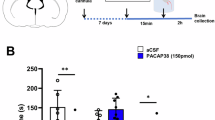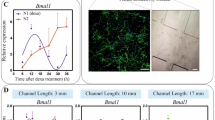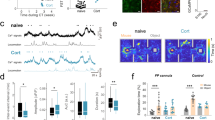Abstract
Astrocytes are known to modulate synaptogenesis or neuronal activities, thus participating in mental functions. It has been shown that astrocytes are involved in the antidepressant mechanism. In this study we investigated the potential hormonal mediator governing the astrocyte-neuron interplay for stress-coping behaviors. Mice were subjected to chronic restraint stress (CRS) for 14 days, and then brain tissue was harvested for analyses. We found that the expression of pituitary adenylate cyclase activating polypeptide (PACAP) and its receptor PAC1 was significantly decreased in astrocytes of the prelimbic (PrL) cortex. By conducting a combination of genetics, in vivo imaging and behavioral assays we demonstrated that PAC1 in cortical astrocytes was necessary for maintaining normal resilience of mice against chronic environmental stress like restraint stress. Furthermore, we showed the enhancement of de novo cortical spine formation and synaptic activity under PACAP-mediated astrocytic activation possibly via the ATP release. The molecular mechanisms suggested that the vesicle homeostasis mediated by PACAP-PAC1 axis in astrocytes was involved in regulating synaptic functions. This study identifies a previously unrecognized route by which neuropeptide modulates cortical functions via local regulation of astrocytes.
This is a preview of subscription content, access via your institution
Access options
Subscribe to this journal
Receive 12 print issues and online access
$259.00 per year
only $21.58 per issue
Buy this article
- Purchase on SpringerLink
- Instant access to full article PDF
Prices may be subject to local taxes which are calculated during checkout







Similar content being viewed by others
References
Shi DD, Zhang YD, Ren YY, Peng SY, Yuan TF, Wang Z. Predictable maternal separation confers adult stress resilience via the medial prefrontal cortex oxytocin signaling pathway in rats. Mol Psychiatry. 2021;26:7296–307.
Wang M, Perova Z, Arenkiel BR, Li B. Synaptic modifications in the medial prefrontal cortex in susceptibility and resilience to stress. J Neurosci. 2014;34:7485–92.
Radley JJ, Rocher AB, Rodriguez A, Ehlenberger DB, Dammann M, McEwen BS, et al. Repeated stress alters dendritic spine morphology in the rat medial prefrontal cortex. J Comp Neurol. 2008;507:1141–50.
Qu Y, Yang C, Ren Q, Ma M, Dong C, Hashimoto K. Regional differences in dendritic spine density confer resilience to chronic social defeat stress. Acta Neuropsychiatr. 2018;30:117–22.
Parkhurst CN, Yang G, Ninan I, Savas JN, Yates JR 3rd, et al. Microglia promote learning-dependent synapse formation through brain-derived neurotrophic factor. Cell. 2013;155:1596–609.
Yao W, Cao Q, Luo S, He L, Yang C, Chen J, et al. Microglial ERK-NRBP1-CREB-BDNF signaling in sustained antidepressant actions of (R)-ketamine. Mol Psychiatry. 2022;27:1618–29.
Allen NJ, Eroglu C. Cell Biology of Astrocyte-Synapse Interactions. Neuron. 2017;96:697–708.
Xie Y, Kuan AT, Wang W, Herbert ZT, Mosto O, Olukoya O, et al. Astrocyte-neuron crosstalk through Hedgehog signaling mediates cortical synapse development. Cell Rep. 2022;38:110416.
Cao X, Li LP, Wang Q, Wu Q, Hu HH, Zhang M, et al. Astrocyte-derived ATP modulates depressive-like behaviors. Nat Med. 2013;19:773–7.
Du Preez A, Onorato D, Eiben I, Musaelyan K, Egeland M, Zunszain PA, et al. Chronic stress followed by social isolation promotes depressive-like behaviour, alters microglial and astrocyte biology and reduces hippocampal neurogenesis in male mice. Brain Behav Immun. 2021;91:24–47.
Re GF, Li H, Yang JQ, Li Y, Zhang Z, Wu X, et al. Exercise modulates central and peripheral inflammatory responses and ameliorates methamphetamine-induced anxiety-like symptoms in mice. Front Mol Neurosci. 2022;15:955799.
Hughes SM, Lillien LE, Raff MC, Rohrer H, Sendtner M. Ciliary neurotrophic factor induces type-2 astrocyte differentiation in culture. Nature. 1988;335:70–3.
Trentin AG, De Aguiar CB, Garcez RC, Alvarez-Silva M. Thyroid hormone modulates the extracellular matrix organization and expression in cerebellar astrocyte: effects on astrocyte adhesion. Glia. 2003;42:359–69.
García-Cáceres C, Quarta C, Varela L, Gao Y, Gruber T, Legutko B, et al. Astrocytic insulin signaling couples brain glucose uptake with nutrient availability. Cell. 2016;166:867–80.
Timper K, Del Río-Martín A, Cremer AL, Bremser S, Alber J, Giavalisco P, et al. GLP-1 receptor signaling in astrocytes regulates fatty acid oxidation, mitochondrial integrity, and function. Cell Metab. 2020;31:1189–1205.e1113.
Müller W, Heinemann U, Berlin K. Cholecystokinin activates CCKB-receptor-mediated Ca-signaling in hippocampal astrocytes. J Neurophysiol. 1997;78:1997–2001.
Anderberg RH, Richard JE, Hansson C, Nissbrandt H, Bergquist F, Skibicka KP. GLP-1 is both anxiogenic and antidepressant; divergent effects of acute and chronic GLP-1 on emotionality. Psychoneuroendocrinology. 2016;65:54–66.
Singh L, Lewis AS, Field MJ, Hughes J, Woodruff GN. Evidence for an involvement of the brain cholecystokinin B receptor in anxiety. Proc Natl Acad Sci USA. 1991;88:1130–3.
Zhang H, Sun Y, Yau SY, Zhou Y, Song X, Zhang HT, et al. Synergistic effects of two naturally occurring iridoids in eliciting a rapid antidepressant action by up-regulating hippocampal PACAP signalling. Br J Pharmacol. 2022;179:4078–91.
Joo KM, Chung YH, Kim MK, Nam RH, Lee BL, Lee KH, et al. Distribution of vasoactive intestinal peptide and pituitary adenylate cyclase-activating polypeptide receptors (VPAC1, VPAC2, and PAC1 receptor) in the rat brain. J Comp Neurol. 2004;476:388–413.
Oliveira JF, Araque A. Astrocyte regulation of neural circuit activity and network states. Glia. 2022;70:1455–66.
Lezmy J. How astrocytic ATP shapes neuronal activity and brain circuits. Curr Opin Neurobiol. 2023;79:102685.
Bonvento G, Bolaños JP. Astrocyte-neuron metabolic cooperation shapes brain activity. Cell Metab. 2021;33:1546–64.
Wu Z, He K, Chen Y, Li H, Pan S, Li B, et al. A sensitive GRAB sensor for detecting extracellular ATP in vitro and in vivo. Neuron. 2022;110:770–782.e775.
Lezmy J, Arancibia-Cárcamo IL, Quintela-López T, Sherman DL, Brophy PJ, Attwell D. Astrocyte Ca2+-evoked ATP release regulates myelinated axon excitability and conduction speed. Science. 2021;374:eabh2858.
Ryu JK, Kim J, Choi SH, Oh YJ, Lee YB, Kim SU, et al. ATP-induced in vivo neurotoxicity in the rat striatum via P2 receptors. Neuroreport. 2002;13:1611–5.
Arimura A, Somogyvari-Vigh A, Weill C, Fiore RC, Tatsuno I, Bay V, et al. PACAP functions as a neurotrophic factor. Ann N. Y Acad Sci. 1994;739:228–43.
Shioda S, Ohtaki H, Nakamachi T, Dohi K, Watanabe J, Nakajo S, et al. Pleiotropic functions of PACAP in the CNS: neuroprotection and neurodevelopment. Ann N. Y Acad Sci. 2006;1070:550–60.
Velasco ER, Florido A, Flores Á, Senabre E, Gomez-Gomez A, Torres A, et al. PACAP-PAC1R modulates fear extinction via the ventromedial hypothalamus. Nat Commun. 2022;13:4374.
Lee EY, Chan LC, Wang H, Lieng J, Hung M, Srinivasan Y, et al. PACAP is a pathogen-inducible resident antimicrobial neuropeptide affording rapid and contextual molecular host defense of the brain. Proc Natl Acad Sci USA 2021;118:e1917623117.
Le N, Sayers S, Mata-Pacheco V, Wagner EJ. The PACAP paradox: dynamic and surprisingly pleiotropic actions in the central regulation of energy homeostasis. Front Endocrinol (Lausanne). 2022;13:877647.
Ressler KJ, Mercer KB, Bradley B, Jovanovic T, Mahan A, Kerley K, et al. Post-traumatic stress disorder is associated with PACAP and the PAC1 receptor. Nature. 2011;470:492–7.
Vallejo M. PACAP signaling to DREAM: a cAMP-dependent pathway that regulates cortical astrogliogenesis. Mol Neurobiol. 2009;39:90–100.
Perez V, Bouschet T, Fernandez C, Bockaert J, Journot L. Dynamic reorganization of the astrocyte actin cytoskeleton elicited by cAMP and PACAP: a role for phosphatidylInositol 3-kinase inhibition. Eur J Neurosci. 2005;21:26–32.
Seo H, Lee K. Epac2 contributes to PACAP-induced astrocytic differentiation through calcium ion influx in neural precursor cells. BMB Rep. 2016;49:128–33.
Blanco-Suárez E, Caldwell AL, Allen NJ. Role of astrocyte-synapse interactions in CNS disorders. J Physiol. 2017;595:1903–16.
Aten S, Kiyoshi CM, Arzola EP, Patterson JA, Taylor AT, Du Y, et al. Ultrastructural view of astrocyte arborization, astrocyte-astrocyte and astrocyte-synapse contacts, intracellular vesicle-like structures, and mitochondrial network. Prog Neurobiol. 2022;213:102264.
Park J, Chung WS. Astrocyte-dependent circuit remodeling by synapse phagocytosis. Curr Opin Neurobiol. 2023;81:102732.
Stogsdill JA, Ramirez J, Liu D, Kim YH, Baldwin KT, Enustun E, et al. Astrocytic neuroligins control astrocyte morphogenesis and synaptogenesis. Nature. 2017;551:192–7.
Cho WH, Noh K, Lee BH, Barcelon E, Jun SB, Park HY, et al. Hippocampal astrocytes modulate anxiety-like behavior. Nat Commun. 2022;13:6536.
Yan L, Wei JA, Yang F, Wang M, Wang S, Cheng T, et al. Physical exercise prevented stress-induced anxiety via improving brain RNA methylation. Adv Sci (Weinh). 2022;9:e2105731.
Hare BD, Shinohara R, Liu RJ, Pothula S, DiLeone RJ, Duman RS. Optogenetic stimulation of medial prefrontal cortex Drd1 neurons produces rapid and long-lasting antidepressant effects. Nat Commun. 2019;10:223.
Striedinger K, Meda P, Scemes E. Exocytosis of ATP from astrocyte progenitors modulates spontaneous Ca2+ oscillations and cell migration. Glia. 2007;55:652–62.
Verderio C, Cagnoli C, Bergami M, Francolini M, Schenk U, Colombo A, et al. TI-VAMP/VAMP7 is the SNARE of secretory lysosomes contributing to ATP secretion from astrocytes. Biol Cell. 2012;104:213–28.
Singh P, Jorgačevski J, Kreft M, Grubišić V, Stout RF Jr, Potokar M, et al. Single-vesicle architecture of synaptobrevin2 in astrocytes. Nat Commun. 2014;5:3780.
Takata-Tsuji F, Chounlamountri N, Do LD, Philippot C, Novion Ducassou J, Couté Y, et al. Microglia modulate gliotransmission through the regulation of VAMP2 proteins in astrocytes. Glia. 2021;69:61–72.
Dutta DJ, Woo DH, Lee PR, Pajevic S, Bukalo O, Huffman WC, et al. Regulation of myelin structure and conduction velocity by perinodal astrocytes. Proc Natl Acad Sci USA. 2018;115:11832–7.
Schwarz Y, Zhao N, Kirchhoff F, Bruns D. Astrocytes control synaptic strength by two distinct v-SNARE-dependent release pathways. Nat Neurosci. 2017;20:1529–39.
Acknowledgements
We thank Prof. Xiang-dong Sun for his help in the 2-photon imaging assays. This work was funded by STI2030-Major Projects (2022ZD0207600) to LZ, National Natural Science Foundation of China (U22A20301 to KFS), Guangdong Major Project of Basic and Applied Basic Research (2023B0303000004) to KFS and LZ, Guangdong Basic and Applied Basic Research Foundation (2023B1515040015) to LZ, Guangdong Special Support Program for Young Talented Researchers (2023TQ07A102) to LZ, Guangzhou Basic and Applied Basic Research Foundation (SL2023A03J00544, SL2024A04J00149) to LZ, The Fundamental Research Funds for the Central Universities (21624207) to LZ, and the Key Research and Development Plan of Ningxia (2022BEG01004) to KFS.
Author information
Authors and Affiliations
Contributions
Conceptualization, JAW, and LZ; Methodology, JAW, JC, XRW, JY, and YFS; Validation, JAW and LZ; Formal analysis, JAW and BRZ; Investigation, JC, XRW, JY, YFS and BRZ.; Resources, JC. and XRW; Data Curation, JAW and LZ; Writing - Original Draft, JAW. and JC; Writing – Review & Editing, LZ and KFS; Visualization, JAW; Supervision, KFS and LZ; Project Administration, LZ; Funding Acquisition, LZ and KFS.
Corresponding authors
Ethics declarations
Competing interests
The authors declare no competing interests.
Supplementary information
Rights and permissions
Springer Nature or its licensor (e.g. a society or other partner) holds exclusive rights to this article under a publishing agreement with the author(s) or other rightsholder(s); author self-archiving of the accepted manuscript version of this article is solely governed by the terms of such publishing agreement and applicable law.
About this article
Cite this article
Cui, J., Wang, Xr., Yu, J. et al. Neuropeptide-mediated activation of astrocytes improves stress resilience in mice by modulating cortical neural synapses. Acta Pharmacol Sin 46, 867–879 (2025). https://doi.org/10.1038/s41401-024-01420-7
Received:
Accepted:
Published:
Issue date:
DOI: https://doi.org/10.1038/s41401-024-01420-7



